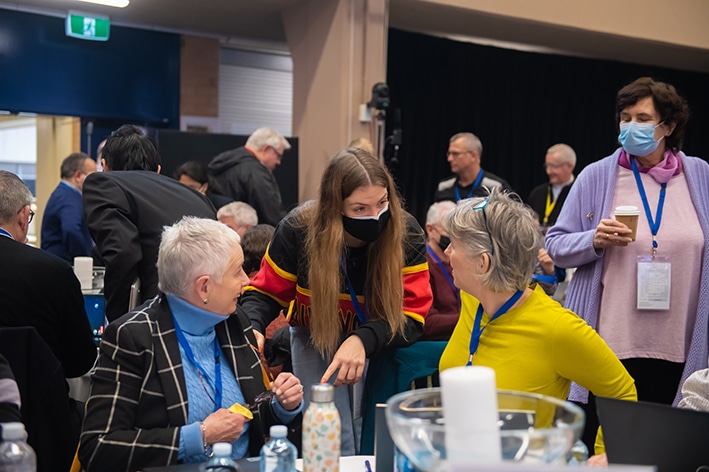
As many will know, the Plenary Council motions on women in the Church all failed to make the required two-thirds majority to pass on Tuesday afternoon.
The subsequent press release said that Plenary members had been invited to ‘deeper discernment’ on this topic.
I must ask: If the vote had gone the other way, would the members also have been invited to ‘deeper discernment’?
It was hard to see what was going on here – except to speculate that some bullying tactics had been employed behind the Plenary Council’s closed doors.
That would be very unsynodal and regrettable. On the other hand, it might be a relief to see people behaving as they really are and saying what they really think. On Monday evening I was saying Vespers – the evening prayer of the Church. The prayers of the faithful began by invoking the women who literally bled out for the love of God – the women martyrs. We asked them to strengthen the Church in time of trial.
Then the married women, who we asked to renew the Church in her apostolic mission. Then the widows, who we asked to make the Church a sign of God’s love. Then the mothers, of whom we asked that the Church would be a true mother.
I couldn’t help but notice that the Church’s liturgy was far more inclusive of ordinary women than our Plenary Council.
But that’s because our Plenary Council was prejudiced towards one type of Catholic woman. She’s over 50, Church-employed, educated, middle-class, and fluent in a range of fashionable causes.
This is me (apart from the job). In fact, I was encouraged to apply to take part in the ‘writing groups’ stage of the Council. I read the position description. It required me to be available for the next 14-18 months for an undisclosed number of meetings, at which we’d talk a lot.
At that time, I was working three days a week, studying full-time on the other four, caring for my frail and elderly parents, and helping to raise a teenage boy who lived under my roof and required special meals, had his first part time job, and was learning to drive.
I didn’t have ten seconds to myself. I certainly didn’t have months to spend with ‘gifted sharers of their personal journeys’ (not ‘parish windbags’ – I stand corrected).
In the absence of ordinary people like me, a group of privileged women and their man friends tried to impose their pet projects on the Plenary Council.
They were clear about what they want. But so far they haven’t told us what the Church will get in return.
I’ve never seen any kind of cost-benefit analysis for a female diaconate. Or even for pay rises in Church agencies. All the women I know who work for the Church are already on public sector-equivalent salaries.
These women are ardent clericalists, pursuing the men they envy. They’re hungry for collars and vestments and the pulpit.”
As for trying to resuscitate the long-dead white elephant Woman and Man: One in Christ Jesus (1999) – the world has changed radically for women in the last 20 years.
This report no longer has anything to offer. It’s as outdated as the brown suede hipster flares I was wearing when it was first published.
These women are ardent clericalists, pursuing the men they envy. They’re hungry for collars and vestments and the pulpit. Any pretense of ‘service’ (diakonos) has quickly gone out the window.
What they also don’t realise is that every other post-Christian church has already abandoned the ordained ministry.
They’ve replaced the Real Presence with eco-deities and ‘spiritualities’. They’ve replaced the real Sacraments with the dubious pleasure of, say, sprinkling one another with wet gum leaves.
This is where our ‘reformers’ are now inevitably heading. When you no longer believe the core realities of Catholicism, the father of lies quickly takes over.
Anyone can summon up a ‘spirit’ from the trees and rocks. Anyone can take part in the ‘sacrament’ of sorting recyclables.
In this future Church in Australia, we won’t need priests. Or deacons, or deaconesses. We’ll just preach to one another while tending the sacred parish compost heap.
In any event – and sad to say – it’s unlikely that Pope Francis will live long enough to see his commission on the diaconate report to him. If it does, it has two broad options.
It can uphold Vatican II’s understanding of the diaconate as part of a continuum of Holy Orders. This means it’s not open to women.
Or it can go back to a more primitive understanding of the diaconate. This means uncoupling it from the priesthood altogether.
Deacons wouldn’t be ordained at all – or ordained in a way that separates them completely from the priesthood.
I’m not sure how our Boomer ladies will feel about that. Or our permanent deacons. But our God is a God of surprises!
Related:
Members happy with revised women’s motions on Plenary’s final day
Plenary motions too constrained by equality-as-power paradigm, say women
